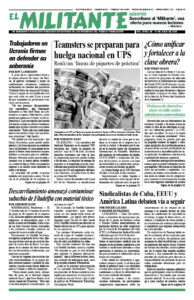The Ukrainian counteroffensive aimed at turning back Moscow’s invasion is “a bit disappointing,” complained retired U.S. Marine Col. Mark Cancian on NPR June 24. His remarks were typical of recent comments by the military brass and officials of President Joseph Biden’s administration.
“The slower than expected pace of the counteroffensive,” Ivana Kottasova said on CNN July 4, means Washington’s support “could become increasingly unsustainable if the conflict drags on.”
These remarks reflect the fact that the U.S. rulers’ response to Moscow’s invasion has always been focused on advancing their own imperialist interests, despite the crocodile tears they shed about the first full-scale land war in Europe in nearly 80 years. Washington has boosted its vast military forces since the start of Moscow’s invasion in preparation for bloody conflicts to come. Every cent spent on its military is to bolster its forces for use against workers at home and against Washington’s rivals and working people abroad.
The pressure from Washington for Kyiv to rush into combat coincides with the stepping up of campaigning for the 2024 election. Biden’s eyes are on the ballot box.
The reason for caution shown by Ukrainian forces is not difficult to see. Moscow has overwhelming air superiority, a much larger army and weapons supply, and has heavily mined its defenses. Despite this, Russian President Vladimir Putin’s regime has been unable to make any serious gains in over a year and continues to get pushed back from areas around Bakhmut, having captured the city only in May.
“We cannot use meat-grinder tactics as the Russians do,” Oleksii Reznikov, Ukraine’s defense minister, told the Washington Post. He was referring to the sacrifice of the lives of tens of thousands of conscript soldiers by the Putin regime in human wave attacks.
What has been decisive in preventing Putin’s regime from seizing Ukraine has been the determination of Ukrainian forces, and of workers, farmers and others who have volunteered for the territorial militias, as well as widespread support from the civilian population.
Their morale is exemplified by Ukrainian filmmaker Oleh Sentsov, who is now a soldier.
Wounded by shrapnel and lying on the ground, Sentsov recorded a video of himself July 8, saying this is the price Ukrainians pay for victory.
He had been injured on the southern front along with two of his comrades. “That was yesterday. It’s better today,” Sentsov commented as the three recovered in the hospital.
Crimean-born Sentsov joined millions of workers and young people who took to the streets for months during the 2014 Maidan uprising. They stood up to deadly assaults from thugs and cops of the pro-Moscow regime of Viktor Yanukovych, eventually overturning his rule. That struggle strengthened the confidence of working people and their determination to defend Ukraine’s independence. It also deepened their concerns about the trustworthiness of the country’s capitalist rulers.
Afterward Sentsov joined protests against the annexation of Crimea by Putin’s forces later that year. He was arrested on trumped-up terrorism charges and sentenced to 20 years imprisonment.
In a penal colony in Siberia, he staged a 145-day hunger strike. An international campaign, in which the Militant participated, helped secure his release in 2019.
“From the first days of war,” Sentsov said, “I joined the Territorial Defense,” helping to repulse Russian tank columns converging on the capital. Ukrainian officials offered him work in the press office “because of my famous name,” he said, “but this was not my path.” He added, “It does not matter if you are a filmmaker or a bus driver or a simple worker — we are all soldiers.”
Thousands of volunteers like him have helped push back Putin’s drive to occupy the country and crush its people. Their morale is in marked contrast to the disaffection spreading among Russian soldiers as well as their families at home.
Heavy Russian casualties
A joint investigation by Russian independent media Meduza and Mediazona, with the BBC, shows that at least three times more Russian soldiers died in Ukraine than Soviet troops over 10 years of war in Afghanistan. And not included are foreign nationals or those mobilized into the proxy units of the self-declared “people’s republics” in Luhansk and Donetsk. Nor does it count the large number of prison inmates lost by the Wagner mercenary forces.
In a July 10 video clip Russian soldiers complain about being punished by a commanding officer. They say they are “locked in this pit for refusing to go the zero line,” the Russian army term for the front. “With a rifle against a tank,” one said, “Army of Russia, this is how we fight.”
In a June 28 video soldiers from another company declare they would refuse to obey orders to return to the “meat grinder” of the front lines.
“Initially,” a soldier said, “we had 150 people. After brutal fights, this is all what’s left us,” gesturing to some 20 men around him.
They feared being “nullified,” he said, without food or water or enough ammunition and they had “never been paid.” The clip, sent to their relatives in Russia, was so they would know “if any of us die,” it would mean “we were killed by our own here, not in combat.”
Putin fears the impact that protests like this can have on wider layers of the Russian population. Backing for the war among working people has never been enthusiastic and continues to wane.

